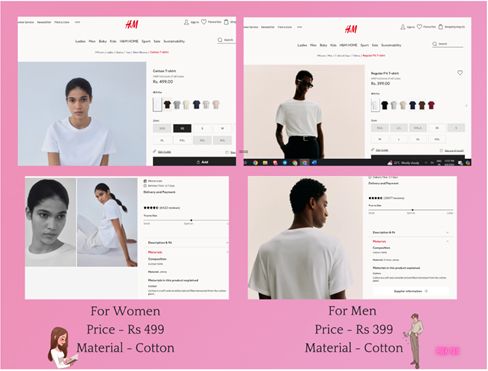- within Consumer Protection topic(s)
- in United States
- with readers working within the Media & Information industries
- within Consumer Protection topic(s)
- in United States
- with readers working within the Media & Information industries
- within Consumer Protection, Intellectual Property and Criminal Law topic(s)
INTRODUCTION -
The "Pink Tax" refers to the unnoticed practice where products and services marketed toward women are often priced higher than similar or identical items marketed toward men. Even though taxes on products are the same regardless of gender, we still see price disparities between products marketed to different genders. One of the primary reasons for this practice is market segmentation, where companies target different demographics with specialized products. In doing so, they often justify higher prices by citing differences in packaging, branding, or even ingredients, even when these differences are minimal or non-existent. Another contributing factor is societal norms and expectations, where women are often expected to spend more on their appearance, reflecting a lack of information. This study will highlight the consequences for women consumers in the coming years. Women, who already face wage gaps and other financial challenges, are disproportionately affected by these higher costs. The Pink Tax highlights systemic pricing practices and raises questions about fairness and consumer rights.
Keywords – Pink Tax, Consumer Protection Law
EVOLUTION OF "PINK TAX" –
The concept of the Pink Tax has gained attention in recent years, but its roots can be traced back decades. Although gender-based pricing disparities have existed for a long time, they weren't well-documented until the term "pink tax" became widely recognized in the late 20th and early 21st centuries. This practice developed over time, mirroring shifts in societal attitudes and economic practices. By the 1980s and 1990s, consumer advocacy groups began highlighting these differences, especially in personal care and clothing. Recent developments in the 2000s confirmed that products for women were often priced higher than similar products for men. In the 2010s, media attention and public awareness led to calls for policy changes, and ongoing advocacy in the 2020s continues to push for fairer pricing practices and legislative action.
INSIGHT INTO THE CONCEPT OF "PINK TAX" –
The Pink Tax refers to the phenomenon where women are charged more for the same products that men also use in their daily lives. This price discrepancy is not an official tax, but rather a reflection of gender-based price discrimination that exists in various sectors, including personal care and clothing.
For example, if 'A' and 'B', a husband and wife, go shopping and buy one piece of the same brand of shaving cream, 'B' may be charged more simply because the product is marketed as "feminine" rather than "masculine," despite having no reasonable justification for the price difference.
DOES "PINK TAX" EXIST IN INDIAN MARKET?
In India, many women are unaware of the price differences between products aimed at women and those aimed at men, which leads them to pay more. This lack of awareness exacerbates the issue, causing women to continuously pay higher prices for similar products. This indicates the ongoing existence of the pink tax.
ARE WOMEN REQUIRED TO PAY "PINK TAX" IN INDIA?
The Indian Government does not impose any tax on women's products; rather, it is a pricing practice some companies employ by charging extra for products. Women should not have to pay more for the same product just because it is marketed differently. If products fall under the same tax slab, the price should be the same for everyone, as these costs can significantly impact women, especially in fields where wage disparities already exist. Research indicates that women pay 7 percent more for general products and 13 percent more for personal items, highlighting the pressing issue of gender-based pricing discrimination. It is also noteworthy that products are increasingly becoming "gendered."
CONSTITUTIONAL VALIDITY OF 'PINK TAX' –
The provisional measures addressing the issue of the "pink tax" in India are currently inadequate. This matter raises significant legal and constitutional concerns regarding equality and discrimination. Although several provisions under the Indian Constitution, such as Article 14 (which guarantees equality before the law), Articles 15 and 16 (which prohibit discrimination), and Article 21 (which ensures the right to live with dignity and personal liberty), are relevant, there has yet to be a decisive legal framework specifically addressing this issue. The question remains whether the right to live with dignity is being infringed upon by forcing women to endure financial and societal burdens.
- Legal Challenges - In the past five years, numerous objections have been raised against this non-voluntary practice, but the judiciary has yet to make a decisive ruling. To address this issue, globally many legal actions have been initiated., similarly, the issue was raised in the case of Schulte v. Cnopco, Inc. (2020)1,'A decision was held that "Plaintiff claims are not amenable to judicial resolution and law does not compel identical products to be sold at the same price" and that the plaintiff's remedy lies with legislation, not litigation.' The evolving debate to invalidate the unfair practice of 'The Pink Tax" is not new and, the matter of discriminatory price was investigated in the case of Lowe v. Walgreens Boots Alliance, Inc., et al (2021)2, the Northern District of California dismissed a lawsuit claiming that Walgreens' hair regrowth treatment for women was priced 1.5 times higher than the male version. "The court ruled that the plaintiff's consumer protection claims were preempted by federal law requiring generic labels to match brand-name labels and stated that California's Unruh Act applies only to services, not products." Several objections have been raised regarding the practice of gender-based pricing discrimination, such as the pink tax but many international acts centered their eyes on services rather than products, also there has been a lack of litigation support yet to challenge these practices effectively.
- Legislative Action to this 'Unfair Practice'- The perspective towards practices like "paying more for being women" has come to notice by many states' legislation, some of them have considered or enacted laws that explicitly prohibit discriminatory pricing systems. However, the legislative became active in taking action which is finalized and some are still pending. To support this "The Pink Tax Repeal Act (2021)3" was introduced to prohibit the pricing of consumer products and services that are substantially similar and this act is currently referred to the Subcommittee on Consumer Protection and Commerce. Simultaneously, In California, the US AB-1287 Bill (2023)4 has been passed, the law targeted higher prices on products marketed for women. Such decisions provide crucial insight into many reforms that are required to be done and get attention worldwide to sustain a non-discriminatory gender-based pricing system.
GLOBAL REPORT ON 'PINK TAX' –
The Department of Consumer Affairs (DCA) New York (2015)5 conducted a survey named 'A Study of Gender Pricing in New York City' including five industrial categories like accessories, children's clothing, adult clothing, personal care products, and home health care products for seniors. The agency compared nearly 800 products with clear male and female versions from more than 90 brands sold at New York City retailers, Across the comparison, DCA found that women's products charged more than 42 percent of the time while men's products cost more than 18 percent of the time. Reports indicate that the pink tax affects everyday items such as personal care products, clothing, and even services. This practice not only impacts women's financial well-being but also perpetuates gender-based economic inequality on a global scale.
PRICE DISPARITY ANALYSIS -

Current Scenario of Existing "Pink Tax" via Brand H.M (2024)
In this case, where a HnM Brand white shirt made of the same cotton material is priced differently based on gender, with boys' shirts costing ₹399 and girls' shirts costing ₹499—indeed illustrates the concept of the pink tax and raises concerns about gender discrimination in pricing.
The ₹100 price difference for the same products based solely on gender suggests that the market is charging women (or girls, in this case) a premium for similar items. This practice can be seen as discriminatory and reinforces negative stereotypes about equal liabilities and consumer goods.
PROPOSED METHODOLOGY TO COMBAT - "PINK TAX"
The interruption of Private Companies should come to an end, the concept of "Pink for Girls and Blue for Boys" has been targeted by such brands, and many parts of consumer industries strike more charges over women. To address gender-based pricing disparities awareness, Campaigns are required to create unique hashtags and run campaigns to highlight unfair pricing practices, aiming for viral reach to form unity and raise awareness. Also, consumers need to seek legal action under consumer protection laws if they believe they are being unfairly charged based on gender. Globally this issue has been raised, boycotting brands and their unfair pricing can shift them towards equitable practices.
CONCLUSION-
The continued practice of the "pink tax" will likely lead to shifts in societal norms. As gender-based pricing disparities persist, they could reinforce the perception that women should bear higher costs for similar products, potentially normalizing such inequities. The economic impact of the pink tax is not noticed, and it puts a limit on the financial efficiency of women. Unnoticed absence of formal government-imposed taxes, the economic implications of the pink tax are profound, magnifying existing inequalities. Ultimately, a discourse on the pink tax is not just about individuals buying decisions but about encouraging a culture of equal opportunity given to all consumers, regardless of gender. Achieving this goal requires collective efforts and a commitment to challenging systemic biases that preserve discrimination. A more equitable marketplace that honors the dignity and rights of every individual can be achieved through unity, awareness, and action.
Reference Link –
- Schulte v. Conopco, Inc. 4:19 CV 2546 RWS (E.D. Mo. Jul. 17, 2020)
- Lowe v. Walgreens Boots Alliance, Inc., et al 3:21-cv-02852
- The Pink Tax Repeal Act (2021) Visit - https://www.congress.gov/bill/117th-congress/house-bill/3853/all-info#:~:text=Introduced%20in%20House%20
(06%2F11%2F2021)&text=This%20bill%20prohibits%20product%20manufacturers,color%2C%20they%20are%20substantially%20similar. - AB-1287 Bill (2023) Visit -https://www.nyc.gov/assets/dca/downloads/pdf/partners/Study-of-Gender-Pricing-in-NYC.pdf
- The Department of Consumer Affairs (DCA) New York (2015) Visit - https://www.nyc.gov/assets/dca/downloads/pdf/partners/Study-of-Gender-Pricing-in-NYC.pdf
- UnPinking Discrimination: Exploring the Pink Tax and its Implications (2016, March 23) Visit - http://ijpsl.in/
- A LEGAL STUDY OF THE APPLICABILITY OF THE PINK TAX IN INDIA (2022, August 8) Visit - https://ijcrt.org/papers/IJCRT2208172.pdf
- Pink Tax in India (2024, June 7) Visit - https://cleartax.in/s/pink-tax-in-india
- The Department of Consumer Affairs (DCA) Visit - https://www.nyc.gov/assets/dca/downloads/pdf/partners/Study-of-Gender-Pricing-in-NYC.pdf
- Investigating the Pink Tax: Evidence against a Systematic Price Premium for Women in CPG (2021, October, 29) Visit - https://www.ftc.gov/system/files/documents/public_events/1588356/mosharybhatiatuchman_updated2
Footnotes
1. Schulte v. Cnopco, Inc. 4:19 CV 2546 RWS (2020)
2. Lowe v. Walgreens Boots Alliance, Inc., et al 3:21-cv-02852(2021)
3. The Pink Tax Repeal Act (2021)
4. AB-1287 Bill (2023)
5. The Department of Consumer Affairs (DCA) New York (2015)
The content of this article is intended to provide a general guide to the subject matter. Specialist advice should be sought about your specific circumstances.


